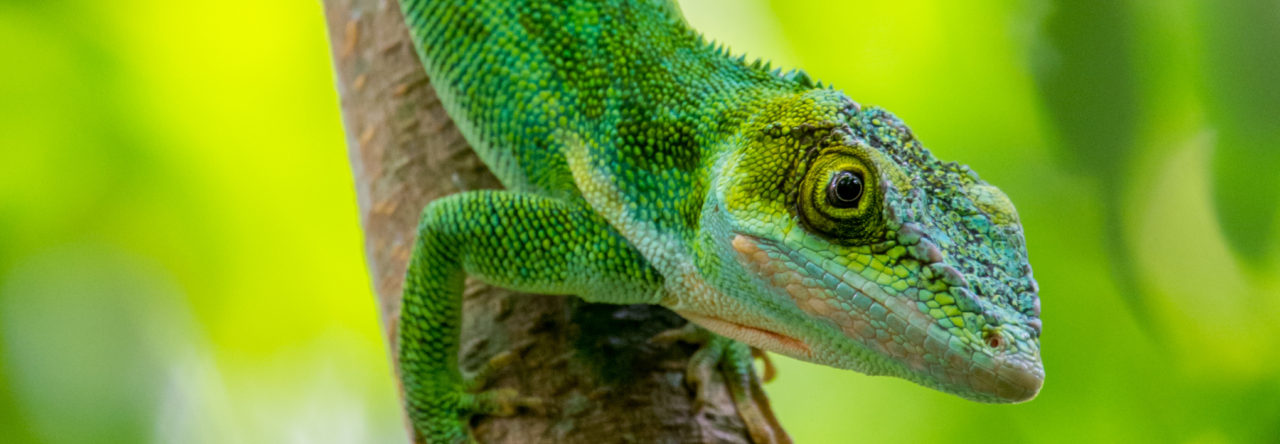Anolis maynardi. Photo by J. Losos
AA commentator and Jamaican student Kuti Ra remarks (links to previous posts added by me:
“I notice a lot of fuss on Anole Annals about the skull morphology of carolinensis clade anoles, so I thought I’d weigh in with a theory of my own. All that you are about to read comes from pure indirect observation and speculation, so please keep that in mind.
First of all, I believe that the skull morphology of these anoles is directly related to their arboreal lifestyle and, more specifically, to the diet that such a lifestyle would facilitate. There have been several posts [1,2] about nectivory in anoles, but all these instances seem to involve carolinensis clade anoles (A. maynardi and A. carolinensis) and possessing a long tapered skull would undoubtedly make such feeding behaviour easier; this could come very useful as a trunk crown anole would encounter several blossoms and such high up in the trees in addition to various small fruits. In this respect, the forceps-like jaws could function something akin to a fruit-eating birds’ bill; considering all this, it would seem that the jaw morphology of carolinensis clade anoles is simply a useful adaptation for life in the canopy. This conclusion seems even more likely when you consider that sexual selection very likely wouldn’t play a role here as observations of Anolis maynardi suggests that longer-snouted males aren’t any more successful at securing mates; and why would they be, having such a long jaw narrow jaw would translate to a lower bite force and thus a less likely chance of emerging as the victor in a territorial battle?

No long schnoz here. Anolis grahami. Photo by J. Losos
Of course, this theory begs the question ‘‘Why didn’t the trunk-crown anoles on other Greater Antillean islands evolve to look like their carolinensis clade counterparts?” In my opinion, the answer is that they didn’t need to. You see, on Jamaica the trunk crown anole, Anolis grahami, has a skull that is overall very similar to the sympatric A. lineatopus, and though they are traditionally classified as belonging to different ecomorphs, I can testify from personal observation that they often share the same micro-habitat and thus compete for the same resources; however since there are only a few ecomorphs present on Jamaica and wherever these two species occur they are of the only common species in that area, the resources available in a particular micro-habitat are often sufficient to support full populations of the two species; thus neither species has reached the point where it needs to adapt to consume different things than the other. Moving on to the neighbouring islands of Hispaniola and Puerto Rico, one can recognize three things: first off, there are a greater number of trunk-ground anoles than on Jamaica, and more trunk-ground anoles than trunk-crown; second, all or almost all of the other ecomorphs are present and third the jaws of the trunk-crown anoles are noticeably longer than that of sympatric trunk ground species (more so on Hispaniola than on Puerto Rico). On these islands, where there are often more species of anole competing for the resources of the trunk-ground niche, as well as additional ecomorphs to occupy other microhabitats, trunk crown anoles are becoming more and more specialized to take advantage of the resources available to them in the trees.
On Cuba, the largest island, there are often a great number of sympatric species of all ecomorphs and thus the habitat use of the anoles there is the most deeply segregated. I have read that in the Cuban rainforest, Anolis porcatus is almost never found out of the canopy; this seems to also be true of A.allisoni. This greater restriction to a particular microhabitat and need to capitalize on the resources found there is what I believe caused the Cuban trunk-crown to evolve such drastic adaptations to a trunk crown lifestyle. Well that’s my theory in a nutshell. I don’t know if all this has been said before but I haven’t been seen it mentioned. Like I said, most of it is based on indirect observation (looking at pictures on Google images) and speculation so I f you see any problems or holes in the theory, or if you’d like me to elaborate on or better explain a particular point, please let me know.
I think it is also important to note that the heads of trunk-crown anoles start out short on Jamaica and steadily get longer until you get to Cuba.
All the scenarios above would apply only to anoles in their natural habitats and not to populations inhabiting urban areas where more resources are available.
 On a side note, have you ever noticed that trunk crown anoles have relatively tiny dewlaps? Perhaps one should look into how the ecomorph dewlaps are affected by those of neighboring ecomorphs. For example no matter what island you go to, the dewlap of any trunk-ground anole will always be comparatively larger than the dewlap of any trunk-crown anole on that island. I haven’t seen all species for Cuba, but I’m still pretty confident about it. I think these two ecomorphs in particular may have some very big effects on each other that no one has noticed yet.
On a side note, have you ever noticed that trunk crown anoles have relatively tiny dewlaps? Perhaps one should look into how the ecomorph dewlaps are affected by those of neighboring ecomorphs. For example no matter what island you go to, the dewlap of any trunk-ground anole will always be comparatively larger than the dewlap of any trunk-crown anole on that island. I haven’t seen all species for Cuba, but I’m still pretty confident about it. I think these two ecomorphs in particular may have some very big effects on each other that no one has noticed yet.






